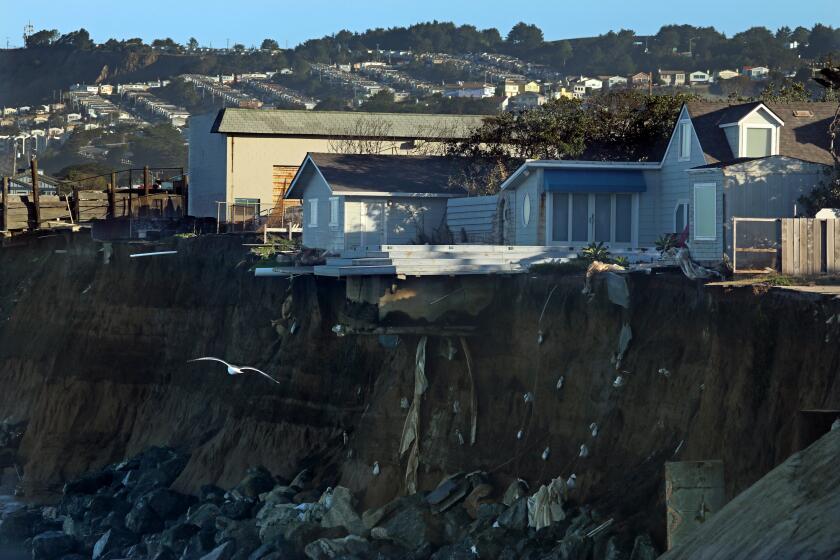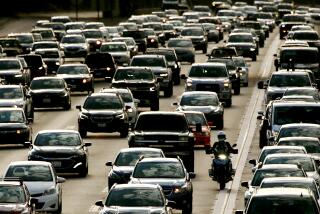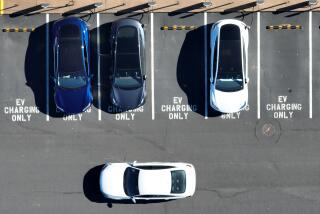Editorial: California’s transportation spending doesn’t match its climate promises

California leaders talk a good game on fighting climate change. But when it comes to cutting the state’s biggest source of planet-warming emissions — cars, trucks, airplanes and other modes of transportation — the spending doesn’t match the rhetoric.
Two recent reports highlight the discrepancy. Regulators have warned that the state needs to slash the amount of miles people drive 25% below 2019 levels to help meet 2030 emission reduction targets. But traffic and car dependence has increased in recent years, according to a report from the progressive advocacy group NextGen Policy.
California’s climate lawsuit against big oil companies isn’t only notable for its pursuit of industry accountability for the damage being caused by fossil fuels. Just as important is its potential to end decades of industry deception about climate change.
It’s no surprise why: California continues to spend the bulk of its transportation dollars to maintain and expand car-centric roads and freeways. Instead of doubling down on the existing system that makes it inconvenient and unsafe to travel by bike, foot and transit, California should be spending the bulk of its transportation funding to remake the urban landscape so people have real choices in how they get around.
But that’s not happening. Of the state’s primary transportation funding programs, just 19% of the money has gone to projects that help reduce the need to drive, such as building out bike lanes, sidewalks, rail service, electric buses and affordable housing near jobs, according to an analysis by the Natural Resources Defense Council. These programs are in such demand that the state is regularly forced to deny funding to highly rated pedestrian and bicycle projects.
The state needs to adopt clearer rules on where it’s risky to build and then make it much easier to build everywhere else.
The NRDC looked at $22.4 billion in spending by 10 transportation programs. About 10% of the money went to expand roads, freeways and interchanges, construction that’s expected to result in more people driving. California is supposed to be rethinking road widenings because such projects only temporarily improve traffic and ultimately lead more people to drive, generating more emissions. But major projects, long in the works, continue to move forward.
About 70% of the state’s transportation dollars go to road maintenance, as required by the state’s gas tax spending plan. That could be an opportunity. Caltrans pledged in 2021 that the agency would use repaving and maintenance projects as an opportunity to transform regular roads into streets that incorporate protected bike lanes, bus lanes and pedestrian safety features.
For the last several years, Culver City has become a model for forward-thinking urban design, supporting a transit-friendly walkable, bikeable downtown. Why go backwards now?
Despite that directive, advocates say Caltrans’ bureaucracy and resistance to change are too often a barrier to transforming streets. (A Caltrans official this month said she was demoted after speaking out about Sacramento-area road widening projects being misrepresented as maintenance projects.)
By now, it should be clear that California cannot meets its 2030 and 2045 climate targets without major changes to the transportation sector, which accounts for half of the state’s greenhouse gas emissions. And simply relying on more people driving more electric vehicles will not get us closer to the climate goals fast enough, not when 75% of vehicles sold in the state are powered by gasoline. The state needs to radically redesign its transportation system to reduce the need for people to drive everywhere all the time.
Funding decisions are statements of priority. It’s time for Gov. Gavin Newsom, lawmakers and top transportation officials to make their transportation spending reflect their climate ambitions.
More to Read
A cure for the common opinion
Get thought-provoking perspectives with our weekly newsletter.
You may occasionally receive promotional content from the Los Angeles Times.













